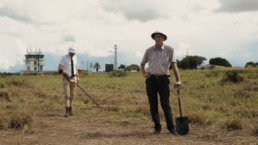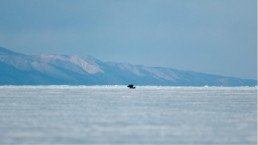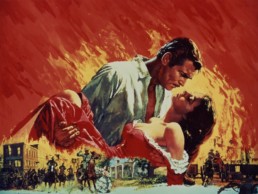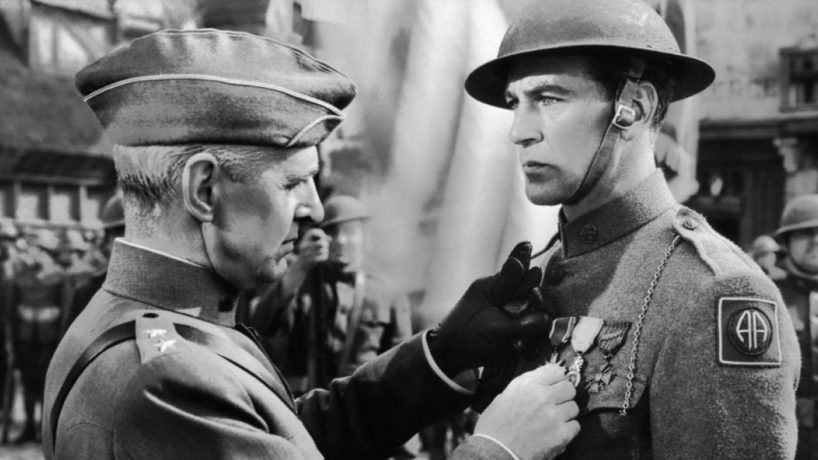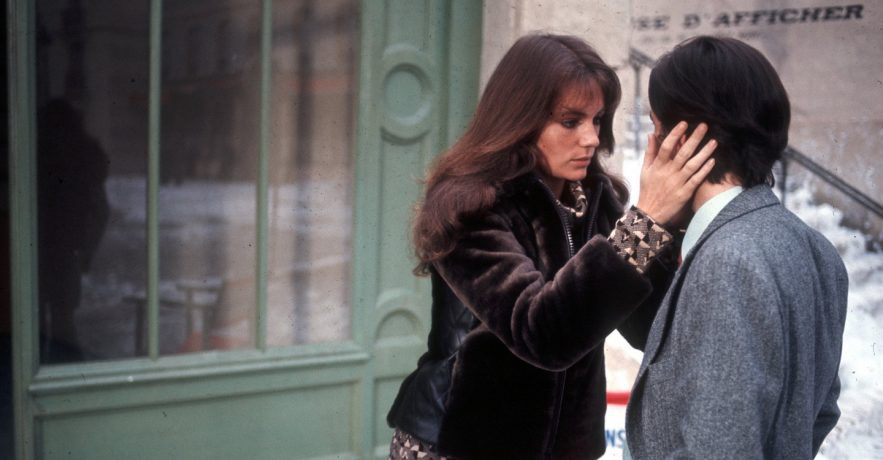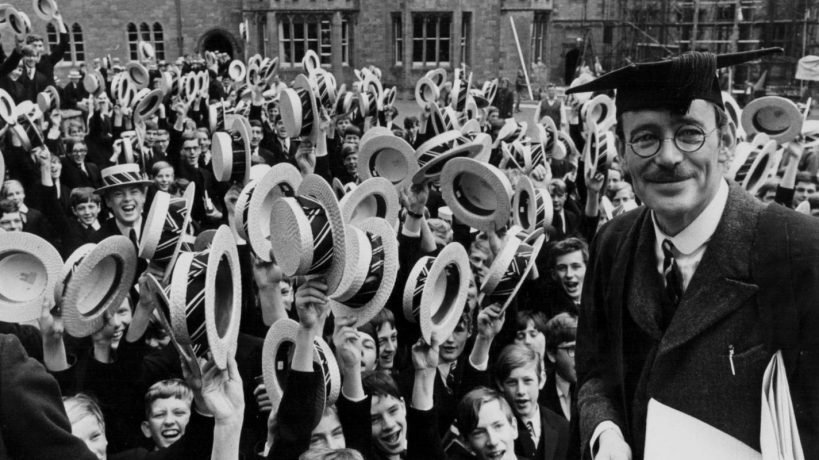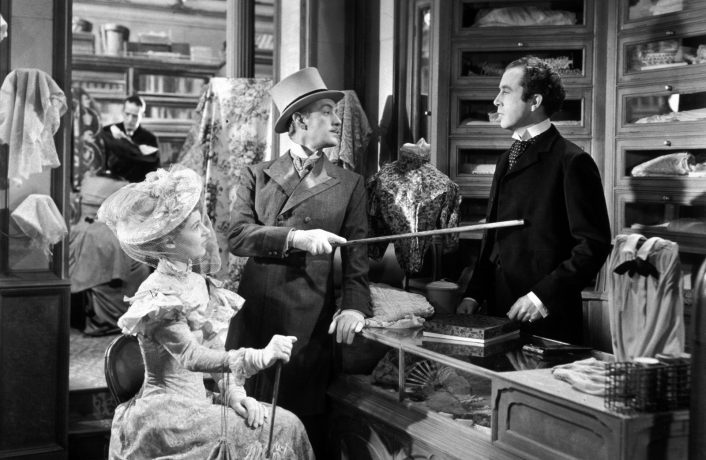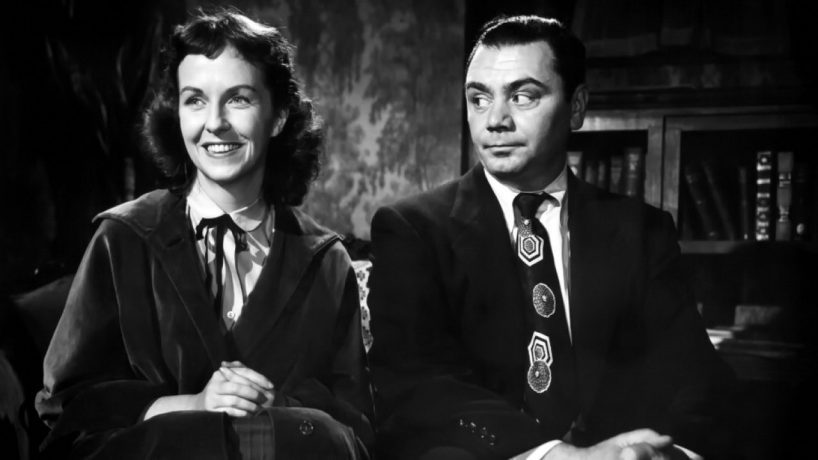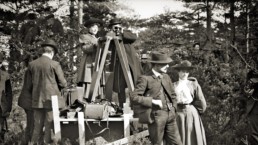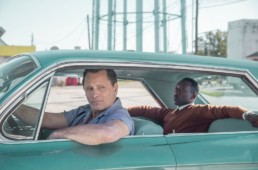Danish Journalist Investigates a Questionable Death in 'Cold Case Hammarskjöld'
COLD CASE HAMMARSKJÖLD (2019)
Starring Mads Brügger, Göran Björkdahl, Dag Hammarskjöld
Directed by Mads Brügger
Distributed by Magnolia Pictures. 128 minutes. Now playing at Alamo Drafthouse Cinema Downtown Los Angeles and Laemmle Monica Film Center.

The research enthusiast in me is inspired by the tenacity in finding a story very well hidden, and dormant for over 50 years. The film enthusiast in me is inspired by how well crafted a story about such research is so well compiled. It’s a dense project, as you can imagine, and at times it doesn’t slow down for the viewer to keep up with the names of subjects and conspirators. Ultimately, though, it’s worth your time to focus and keep up with every step of the way. The role Brügger plays pays off as we get a front-row seat to the challenges and frustrations of researching such a challenging story. Not every lead is successful; the film wisely includes some false trails so that we never know if a particular moment will be fruitful or futile.
'Aquarela' is a Near-Wordless Ode to the Natural World
AQUARELA (2019)
Directed by Viktor Kossakovsky
Distributed by Sony Pictures Classics. 89 minutes. Opening 8/16 at ArcLight Hollywood and AMC Century City 15.
Perhaps the best summarization that could exist for Aquarela, Russian director Viktor Kossakovsky’s ode to the raw power of the natural world, would be “the main character is water.” If you’re looking for a documentary with sit-down interviews, talking points, statistics, narration, or some sort of direct action plan and you see Aquarela, you will be disappointed, but that’s a bit like showing up to a tearjerker and complaining there aren’t enough jokes. So for intrigued viewers, it’s best to have some preparation for the upcoming experience.
Readers may note my love experimental documentaries that push the boundaries of cinema - they appear frequently in my writing because they deserve any additional publicity for their efforts. By premise alone, Aquarela appealed to me in the same way that Jennifer Peedom’s Mountain was an immensely satisfying ode to nature. Yet after seeing Aquarela, by comparison, even Peedom’s film, rooted by Willem Dafoe’s narration and an incomparable soundtrack, feels conventional. Aquarela doesn’t hold your hand in any way - it asks you to see nature, specifically water, in all its forms and develop your own narration as the film unfolds.
Starting with ice, the film begins in Siberia on the frozen waters of Lake Baikal. There’s a looming sense that the ice is melting faster than it should be. To its credit, the film never panders to climate change action - anyone seeing this film can decipher that climate change is an active part of any nature doc; it’s suggested in subtle, powerful ways. Extended shots of men walking around on the frozen lake, doing some sort of work, pay off into a tremendous, unbelievable sequence involving the recovery of items under the frozen surface. Without saying what the result is, it’s priceless. As a 15 minute short film, it would win the documentary Oscar (or go viral, depending on its end goal).
This is the most approachable section of the film - from there, we enter into the more alternative, experimental approaches to storytelling. We watch the numerous stages of water, fully realized in stunning, high-frame-rate footage that captures its raw power, whether as ice, waves, steam or somewhere in between the stages of liquid. It will work for some - it’s no doubt deliberate and deftly executed. Others will be alienated by its near-wordless approach. So long as you know what you’re getting into, the experience is yours to determine.
https://www.youtube.com/watch?v=3xAIuDF25kE
Catch a live performance of 'Did You Wonder Who Fired The Gun?'
In the old fashioned realm of going to the movies, checking the local newspaper for a take on film reviews was an integral step in the decision-making process for what to see. Denver film critic Howie Movshovitz recalled his proudest moment as a film critic wrote a glowing review of the Canadian film, “Strangers in Good Company,” scheduled for only a 4-day run: his review boosted the film’s success and allowed it the opportunity to play for 4 weeks.
Certainly, in the era of Rotten Tomatoes and the era of streaming (not to mention the dearth of print media), film criticism as a means to bring audiences to event cinema is rare. Therefore, when the opportunity to bring in a local audience arises, one must gather all hands on deck to ensure a suitable size audience. I have been a film enthusiast long before I wrote reviews. I’ve been on the receiving end of this recently: glowing coverage of the incomparable War and Peace from the New York Times led me and Ryan Rojas to seek out a 1-day exclusive screening at Santa Monica’s Aero Theater in March, a sold-out show that produced an encore at the Egyptian in April. In other words, when the event is right, critics can still be the ones to guide viewers to journey into independent cinema, especially for film events with limited engagement.
****
All this prelude builds to a must-attend, one-night-only, cinematic event happening in LA next Tuesday, July 23. Documentary filmmaker Travis Wilkerson performs a live rendition of his cinematic memoir Did You Wonder Who Fired the Gun? for the first (and perhaps only) time in Los Angeles.
The film, in either the live rendition or traditional format, has never been shown in theaters in the greater LA area. I know this because I had the privilege of seeing the film at Sundance Film Festival in January 2017 at its world premiere, also featuring a live performance from Travis Wilkerson, and have waited for it closely ever since. I wrote an enthusiastic review in conjunction with the other excellent films I got to see that day. The experience was so mesmerizing that afterward, I doggedly followed the film’s website and the distributor Grasshopper Films’ website, waiting for a chance to see the film again.
Travis Wilkerson is the writer, director, editor, and narrator of this complex, gut-wrenching exposé of his own family’s complex legacy of white power in the rural South. Wilkerson is the direct descendant of a man who was proud of the fact that he killed a black man and got away with it. With fragments of archival, Wilkerson comes to terms with the horrific racism among his own kin, and how to grapple with this as a progressive individual in the 21st century. The story unfolds like a detective novel in real-time, as Wilkerson retraces the steps of the crime which up until now had remained buried. We are taken with him on the journey through the Deep South and, in minimalist imagery, are transported to a part of the country that feels altogether foreign from anything we know in California or the West.
The live component is vital to this experience. This is Wilkerson’s story: he is an active participant in the journey, and to see him deliver it live, at times quite literally editing and sound mixing on the fly while reading raw narration of his own personal odyssey, is incomparable. In most cases, these “live” cinematic experiences are only available at premier film festivals like Sundance. To get to see this in LA is a gift of an opportunity. Adding to the stakes: the ticket itself says this may be the last time Wilkerson ever delivers the live performance. Even at the Sundance world premiere, during the Q&A, Wilkerson candidly expressed the painful nature of the subject meant he had few intentions of going around doing the show. Hence, the need for a taped version, which I have yet to see having been treated to the live showing. With this in mind, it gives extra importance to this evening next Tuesday: antithetical to most cinema, this is something that cannot be brought home or streamed on VOD after the fact. This is a one-and-done, cannot-miss moment for independent cinema enthusiasts.
As avid readers of the Los Angeles independent film scene, I invite you to join me next Tuesday for an unforgettable event.
Travis Wilkerson’s live performance of Did You Wonder Who Fired the Gun? will play next Tuesday, July 23rd, at 8:00 pm at the Velaslavasay Panorama, 1122 W 24th St, Los Angeles, CA 90007
Tickets are $12, more information available here: https://wilkerson.bpt.me/
Our Recap of the 2019 TCM Classic Film Fest 2019
The TCM Classic Film Festival is a haven for movie lovers to watch timeless films on the big screen, the way they were meant to be seen. Whether you've seen a film once, twice, or not at all, watching a classic film in a theater with fellow cinephiles is a heartwarming experience. This year, we're discussing Sgt. York, Day For Night, Goodbye Mr. Chips, Gone With The Wind, Kind Hearts and Coronets, and Marty (for a behind-the-scenes look at this year's festival, click here).
Sgt. York
A Best Picture nominee in 1941, Sgt. York was released weeks before Pearl Harbor shocked Americans to the core and proved to be the perfect picture for wartime inspiration. The titular Sergeant, played by Gary Cooper, starts out as a country bumpkin from Tennessee whose only pastimes are drinking and shooting guns. We watch a character transformation as York finds his way to religion first, then a love of country brought on by The Great War, and a call to arms he must participate in. It harkens back to a time where patriotism had a much different meaning and Americans were realizing just how much their country as a whole meant to them. It’s definitely a worthwhile watch for a socio-political perspective, and a fairly compelling look at an unexpected hero and how he came to be such.
This TCM screening was made extra special by being the inaugural screening at a brand new movie theater: The Legion Theater at Post 43, a military club on Highland Avenue with a spectacular new theater. In person was both the son and grandson of Sgt. York, who have both served in the military themselves and actively participate in sharing their father’s legacy.
Day for Night
This 70s French movie about the making of a movie has gone on to influence dozens of similar films, both sprawling ensemble pictures as well as stories about the motion picture industry behind the scenes. If I say that it’s a movie about making movies, you can almost picture it all. Seeing Nashville in the same festival, it’s clear even Altman, the master of the ensemble, emulated similar story components that Truffaut established. Tropes I’ve seen countless times all seem to originate here: the actress who forgets her lines, the expensive sequence with a disastrous camera error, and of course lots of love affairs and passionate secrets. This movie may not have resonated with me as much given how many similar movies I’ve seen, but is nonetheless a pioneering film infused with some great French culture that affirms its place as a classic.
Goodbye Mr. Chips
This unabashedly sentimental film is a favorite of my dear grandma, and so I owed it to her to finally check it out at this year’s TCM festival. The titular Mr. Chips (Robert Donat in an Oscar-winning role) is an aging teacher at a boys prep academy who has been at the school so long he is its heart and soul. Generations of teaching schoolboys have made him wise and more than a tad eccentric and we see how he became such a staple of the school through flashbacks.
Goodbye Mr. Chips is comedic, tragic, and altogether heart-warming motion picture. In the film’s introduction, the speaker said to the packed audience, “you either had a Mr. Chips in your life, or you didn’t.” I was fortunate to have a few “Chips” in my formative years and suffice to say, the film is definitely a touching reminder of the great educators who helped us along the way.
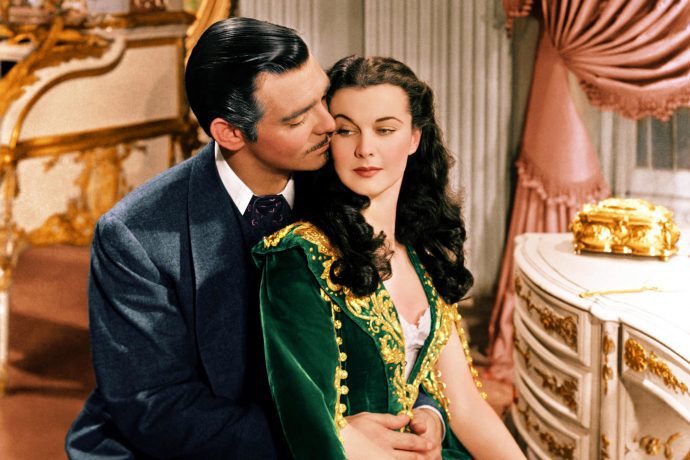
Gone with the Wind
At all times, we film lovers have one movie that people are most shocked we haven’t seen. For years, that movie for me probably has been Gone With the Wind. I’m certainly glad I waited to see it: this meant I could view it on the 25th anniversary of TCM Channel, at the Chinese theater, on a spectacular print that looks as spotless as if it were made yesterday, despite being a film made 80 years ago. Sometimes, movies are worth waiting for the right opportunity to check out.
Unfortunately, the aesthetics are where my praise of this acclaimed film ends. While I knew the film took place in the South during the Civil War, I had no idea to what extent it is a shameless romanticization of the “Old South” described as a beautiful land of prosperity. From the saccharine prologue text, all the way up until intermission, it seems like every moment wants to infuse nostalgia for the era and the lifestyle of the affluent plantation owners who serve as the protagonists. (The second half is less epic but substantially less problematic). Slavery is not ignored, far worse: it is presented as a way of life with harmony and prosperity. Countless times I found myself in utter shock with the perspective through which the film repurposes American history to its own unsettling opinion, enough to warrant a direct comparison to The Birth of a Nation. Yet for some reason, the two films have aged far differently from film historians.
Ultimately there is much more to say about this film than a short review will allow for. My short takeaway is that from a modern day viewer, celebrations of this movie may need a second look. TCM Classic Film Festival hosted a conversation about the controversies associated with the film’s ornate legacy: I wish I had been able to see and hear this talk and am still hoping someone recorded it and will post online. I hold many classics near and dear to my heart. This will not be one of them. Nonetheless, I am grateful for the breadth of movies that TCM has given access to and believe that all movies, no matter how unpleasant, deserve to be made available for viewing and study.
Kind Hearts and Coronets
While today’s audiences may know Sir Alec Guinness best for his role as Obi-Wan Kenobi, in the mid-20th century he was a star known for his zany comedy, the likes of which included The Ladykillers, The Man in the White Suit, and this film- Kind Hearts and Coronets. The draw here is that Guinness plays 6 different roles (8 depending on how you count), each a snobbish heir to a vast fortune, and a target for murder by a cunning heir further down in the lineage. What we’re seeing is the initial seeds of what would become a staple of comedy: the multi-character routine seen here appears to be a major inspiration for Eddie Murphy and Mike Myers, among others. The film’s darkly funny plot seems to have influenced Sunset Blvd (which came out the next year) and many other comedies that deal with murder, money, and family.
In person to introduce the film was Jefferson Mays (The Ballad of Buster Scruggs, Inherent Vice), who performed the same set of 6+ roles on stage and described the countless costume changes that sometimes were only 10 seconds long! This is a fun movie and I’m sure seeing a stage version would be equally entertaining.
Marty
The Best Picture winner from 1955 has been earmarked by me for a while given the superlative that at just 90 minutes, it is the shortest movie ever to win the top Oscar. Contextualizing it further, in the same era that grandiose movies like Around the World in 80 Days and Ben-Hur were being celebrated by the Academy, it makes it all the more incredible that Marty, a slice of life comedy, could take home the gold.
Before it started, the woman sitting next to me asked if I had seen it before - when I said I hadn’t, she smiled and said: “Oh, you are in for a treat.” And she was right: I grinned from ear to ear for the entire duration as we follow Marty (Ernest Borgnine, in an Oscar-winning performance), a down-on-his-luck bachelor whose entire community won’t leave him alone about the fact that he’s not married. Many classic movies require a reframing, as certain elements are hard to view in today’s light. Marty requires no such thinking - the story is timeless and resonates as deeply today as it would’ve upon release. For me, this is the true definition of a classic, a new all-time favorite, and a movie that will stand the test of time for generations to come.
'Be Natural: The Untold Story of Alice Guy-Blaché' Review: The First Female Filmmaker
BE NATURAL: THE UNTOLD STORY OF ALICE GUY-BLACHÉ (2019)
Starring Alice Guy-Blaché, Jodie Foster
Directed by Pamela B. Green
Distributed by Zeitgeist Films in association with Kino Lorber. 103 minutes. Not Rated.
In the opening moments of Be Natural, director Pamela B. Green drops us into an animated rendering of present-day Hollywood, then visually winds back the clock of cinematic history to the late 1800s. With this stunning and impressive visual entrance into our story, the effect is twofold. First, it establishes the incredible motion graphics driven style we’re about to bask in for the film’s runtime. Green previously made title sequences for scores of big Hollywood movies, and her mastery of the motion graphics medium is in full force here. Second, on a more metaphorical level, this rewind speaks to the heart of the message: for generations, movie lovers have learned about the history of cinema as a constructed story. Perhaps, as we learn here, this story was modified to propel or diminish certain filmmakers. Who were the filmmakers that historians omitted in order to fit their agenda?
In late 1800s Paris, the same time at which the Lumiere Bros. and Georges Melies were making the first moving pictures, another filmmaker, Alice Guy-Blaché, was also writing, directing, and producing the first motion pictures. Yes, this makes Guy-Blaché the first female film director, yet before this movie, she’s never been placed in the history books as such. Using meticulous citation and multimedia evidence to back these claims, the film makes a case for not only why she was forgotten, but why she needs to be remembered.
Not only is the film a story of Guy-Blaché, but time is equally allotted for the investigative journey to tracking down all this information. These sequences are thoroughly engaging for people who do similar types of field work, and presumably for anyone who enjoys a window into the process. Had this information been compiled before, we’d already know it - therefore it’s equally valuable to know how the film came to be. It’s at times a dizzying array of interconnected intel, yet even if you can’t keep up with all of it, it plays like fireworks thanks to the aforementioned masterful graphics.
The investigation is intercut with the narrative of the findings themselves, which is the history of Guy-Blaché’s life. These sections are narrated by Jodie Foster, whose French proficiency is on full display. Pioneering examples of story structure, editing, color, sound, and other essential contributions to film innovation are clearly shown in Guy-Blaché’s body of work. A particular moment I enjoyed was how she filmed turning on a lantern: when it’s off the film cell is colored blue, then it cuts to an orange colored cell once it turns on - an early example of using the technology and editing to tell a relatable story. I would’ve liked to see more of Guy-Blaché’s work play out in full: the moments where the film allows it to do so are stunning with the surrounding context. Perhaps Kino Lorber or another specialty distributor will make Guy-Blaché’s films commercially available after this film - here’s hoping.
The end result feels like a crossover between Finding Vivian Maier and Dawson City: Frozen Time, two of my all-time favorite documentaries, each with an engaging, investigative look at history (and in the case of Dawson City, both deal with the birth of cinema). We’re at a time where it’s increasingly clear how fragmented or revised our understanding of history is, and it’s made unfortunately clear that a lot of that has to do with the patriarchal structure that continues to diminish the voices of female filmmakers. Be Natural is an imperative affirmation that female filmmakers have been making groundbreaking movies since the beginning of the medium, and should be recognized for the massive contributions they’ve added to this beloved art. Be Natural is a must-see for movie enthusiasts and will begin the amendment of film history to include Alice Guy-Blaché’s name in the highest echelon for innovating the craft.
Be Natural: The Untold Story of Alice Guy-Blaché is now playing at Laemmle's Monica Film Center.
'Cold War' is a Masterful Triple Threat
There is nothing more satisfying than watching a film from a master director.
Backing up a second, I’m someone who follows directors the way people follow sports teams or, closer to home, movie stars. When I hear that Aronofsky, McQueen, Iñarritu or countless other working directors have a new movie, I’m immediately sold on seeing it without the need for trailers or marketing. And this list is ever-growing and hardly limited to the juggernaut names.
In the case of Polish director Pawel Pawlikowski, it only took one film, 2014’s Foreign Oscar winner Ida, to add him to my director’s list. Seeing Cold War wasn’t a question of if, but when. So I’ll be upfront in saying that the film lives up to its predecessor and is a brilliant companion to Pawlikowski’s previous film. For those unsold by that alone, let me further make a case for this new entry.
Opposites attract at a Polish music conservatory
Shot in a visually distinct, entirely black and white square ratio, we’re transported to 1949 Poland within seconds. The war in Europe is over, yet no less divided between East and West. Our first protagonist, Wiktor (Tomasz Kot), an accomplished musician and conductor, is part of a program seeking out peasants who can play traditional Polish music to participate in a newly formed musical conservatory. The goal is earnest preservation of national heritage yet as it grows, it faces increased pressure to be nationalistic and favor propaganda over traditional music. This tension resonates with so many countries, including our own, and by tapping into the ultra-specific it successfully creates something universal.
This is only the starting point. The 90-minute runtime is packed tight with narrative beats. The larger journey begins when Wiktor takes a liking to one of the conservatory’s brightest stars, Zula (Joanna Kulig), and despite their different roles in the conservatory, they fall passionately in love. Over the course of a few years, their love story intertwines with the European conflict at hand, and their opposite personalities make for both passion and often conflict.
The cinematography is worth the admission alone
What makes Cold War riveting is not entirely the story at hand, but the film’s delivery of material. Cinematographer Lukasz Zal (who co-shot Ida and was nominated for the cinematography Oscar), gets to use the camera as the ultimate storytelling device. Most films are lucky to have one or two unforgettable shots that get burned into the retinas. Cold War has at least a dozen. Some are like magic tricks in their simplicity or creative reveal of key information. Others are more stunningly beautiful in an Ansel Adams, magnificently black and white styling. None are mundane or incidental. I won’t spoil these wondrous photographic moments, they are worth the admission alone.
The language barrier doesn't get in the way of the music's angelic quality
The music is another powerful element that is embedded harmoniously into the story, which is unsurprising given its subjects. Most of the music is in a foreign language, giving it an angelic quality beyond the sound of mortal humankind. Not only is it graceful and pleasing to hear, but like the photography, the film uses it as a narrative device to further the story. Most of this may go over viewers heads because of the language barrier, mine included, and yet you can trust it’s all deliberate because the few songs you do recognize are perfectly implemented.
A winning combination of story, photography, and music
These combined forces of story, photography, and music are what make Cold War a must-see, especially on a big screen. Pawlikowski claims he did not set out to make another film so similar to Ida in aesthetic, and yet the two are as perfect as companion pieces as they come. They entirely stand on their own but are complementary as a pair. Whatever Pawlikowski decides to do next, consider my ticket already bought. In the meantime, I’ll be soaking up the emotional experience of Cold War for many days to come.
'Cold War' is rated R for some sexual content, nudity, and language. 88 minutes. Opening this Friday at Laemmle Royal.
'Green Book' Review: Touring the Deep South, 1962
In turbulent times such as the present, can a movie successfully discuss racial history, while still leaving eager Christmas audiences feeling good?
Awards contender and director Peter Farrelly’s first venture into dramatic territory, Green Book, aims to answer that question. 29 years ago, Best Picture winner Driving Miss Daisy aimed to do something similar, telling the story of a black chauffeur hired to take around an old woman, resulting in a sentimental friendship. As Spike Lee will remind you any chance he gets, that film is dicey in its depiction of racial sub servitude, and so the years have not been kind to Miss Daisy. Modern audiences have realized that the same year, a more relevant and well-executed film about race was released (yes, that’s Spike Lee’s Do The Right Thing).
Many wide-appealing films about racial friendships have been released over the years, but Green Book is seemingly the first to directly revert Daisy: this time, it’s a white driver driving around a gifted black jazz pianist. Tony Lip (Viggo Mortensen, in a transformative role) is an Italian bouncer with a hint of bigotry but without a job to match his tough guy attitude. Unexpectedly, he gets a call from Dr. Don Shirley (Mahershala Ali, similarly disappearing into his role). Shirley is a high-brow man of academia, defying the crude stereotypes associated with African-Americans even today. Through the course of the film, we watch as these two misfits, each playing against the traditional role of their race, navigate the Deep South and make their own journey toward friendship.
On paper it sounds like all the boxes being checked for awards victory, right? The result may appeal to some voters, but the undeniable reality is, this is a mild movie. It’s the equivalent of something you consume with little flavor that merely qualifies as filling enough to hold you over until breakfast. With a film entirely about two characters learning to meet in the middle, and no other plot elements to sustain 130 minutes, the film rests its entire weight on Mortensen and Ali, who are up to the task but cannot make up for a lack of any other compelling elements. We skim through a series of episodes where the racial laws and relationships are tested, and these two characters have to figure out how to respond. Complex themes are addressed but never elaborated on. Why are these Southerners comfortable listening to Dr. Shirley play music and shaking his hand afterward, but still occupy a place of bigotry? How does Northern racism differ from Southern? The unanswered list is long. Even the theme of sexual orientation followed by acceptance is addressed… then skimmed over without any consequence to the story. The slow burn nature of it means the same approach is taken with nearly every development: it comes in, we sit with it for a few minutes, then move on.
And because the film is loosely based on a true story, we’re given a saccharine conclusion that feels hard to believe and a little too neat for a country that’s far from resolved its race relations.
This all goes without mentioning the questionable racial relationships that the film portrays. Indiewire and Shadow and Act have already written about its problematic portrayal of a black character as merely a vehicle to bring the white character to a more tolerant place. The overall takeaway is that because one of the writers was the son of real-life Tony Lip, and because Dr. Shirley was allegedly much more secretive about his life, we inevitably get a well-defined white character and a more ambiguous black character. As those articles mention, this comes across as irresponsible research to favor a white savior story.
Their points are valid and I’m glad to have read them before writing my own. I’ll bring up one detail that, to no surprise, is irritating. Our introduction to Dr. Shirley as a man of sophistication shows his apartment as ornate with treasures from around the world, setting the stage for him as a worldly man of culture. Guess which prop gets the most prominent screen time? Two full-size ivory tusks. Tony is clearly intimidated by them, there’s a quick joke, and Dr. Shirley nods his head as if to justify them. Anyone who reads my reviews knows ivory is an immediate red-flag issue for me, and this handling of it is unsurprisingly misinformed. Ivory, especially in this period, would undoubtedly have arrived in Dr. Shirley’s hands at the result of slave labor (not to mention the killing of an elephant). All ivory is exploitive, and the association of ivory with sophistication is downright disturbing to see in a 2018 release, and doubly insulting considering the man is African-American, as well as a pianist. Steinway, the piano brand of choice in the film, stopped using ivory for their keys in the 1950s. This brief moment, to be overlooked by most, speaks to me as ignorant and regressive.
Moving on, the depiction of music is actually a highlight of the film: Dr. Shirley plays jazz but yearns to play more classical music. Some incredible sequence of movie magic show Mahershala Ali playing piano like a maestro: it’s an understated feat in visual effects. As a Chopin fan myself I could’ve asked for more of these moments and not been unsatisfied.
Other than that, Green Book is much more of an embrace of traditional Americana than a critique. Tony Lip loves his food (watching Mortensen eat may be the most entertaining part of the movie), and the movie would rather celebrate Kentucky Fried Chicken than reflect on the brutal stereotypes associated with fried food and African-American culture. Tony’s hyper-masculine, tough guy approach to problems is aptly critiqued, yet in the end, it is celebrated (notably with a cringe-worthy moment involving a gun). And because the film is loosely based on a true story, we’re given a saccharine conclusion that feels hard to believe and a little too neat for a country that’s far from resolved its race relations.
All this to be said, Green Book is likely the safest choice of awards movies to take an entire family to this season (excluding the new Mary Poppins). Without looking closely it is harmless and inoffensive. It may wear that as a compliment, and undoubtedly this was its intention. Yet even in turbulent times, we as a collective consciousness are beyond movies with such simple views on black/white race relations. Every movie that attempts to simplify (thinking of Blind Side and The Help) may taste sweet in the present moment, but ends up having the lifespan of bubblegum and fails to teach us anything meaningful with regards to race. Green Book feels as egregious (if not more) than the other movies in this subgenre. With its awards frontrunner status in mind, it seems like this celebration is largely misguided, and should be reserved for more deftly executed and forward-thinking films, of which there are many. We’ll see how this unfolds.
'Green Book' is rated PG-13 for thematic content, language including racial epithets, smoking, some violence and suggestive material. 130 minutes. Now playing in theaters everywhere.
'The Advocates' Review: Impossible to Ignore
Part of any successful film festival includes a local angle, shedding light on stories directly affecting the crowd attending screenings.
The LA Film Festival has found room for this, and given the vast number of compelling and important stories in Los Angeles (fiction and non-fiction), this will continue to be vital.
Amidst the lineup, The Advocates stands out given it is a topic that is impossible to ignore as an LA resident: the homeless population. It’s a nationwide problem with unmatched peaks in LA. As one subject Mel Tillekeratne says in the film, one wrong turn on your way home and you can stumble across a neighborhood-sized encampment of homeless people. The same story happened to me earlier this year and is commonplace for LA residents.
With the title in mind, the film focuses on the point of view of a few standout social workers on the ground level trying to help individuals get on their feet and make a difference wherever they can. One of them, Rudy Salinas, is constantly running around town, helping people who are suffering from mental illness from self-sabotaging themselves. His care for the individuals has a clear difference, and the film works best when we see him taking such an active role in bettering various people’s lives. We also see the very real burnout. When up against systems that do no favors to the marginalized, it takes an exceptional being to keep at it without losing patience. Advocate Claudia Perez provides a sense of heart, having overcome so much herself and translating that toward returning the favor. Their two stories and the heart and soul of the film.
...perhaps seeing this film can simply remind us all to be more compassionate to our neighbors who do not share the privilege of housing security...
Occasionally the film departs from the vérité approach and discusses the problem from a macro point of view. This is essential, as more education on the subject allows for the individual stories to carry significance. Discussion of various measures on ballots, specifically “HHH” and “H” from two previous elections, ring a bell to LA residents as they’re mentioned. At the time, these seemed like nothing more than a letter on a checklist. Seeing this gives significant understanding to their existence.
Despite the positive message and important topic of the film, there are some technical hiccups that are hard to ignore and unfortunately, detract from its message. Clumsy transitions throughout the entire runtime take away from a sense of unity and make the film feel rough around the edges. The subject of LA homelessness is such a massive problem that the film occasionally suffers from the push-pull of trying to capture it all while still remaining intimate and grounded.
There isn’t a clear takeaway solution, because ultimately a 90-minute documentary can’t whisk away LA’s homeless, and there is so much to be done. What the film does leave viewers with is a sense of renewed appreciation for its namesake: the advocates who are working day in and day out to keep fighting for the individuals against all odds. Their tenacity is courageous and worthy of being championed. Most film festival attendees will not be directly suffering from homelessness: perhaps seeing this film can simply remind us all to be more compassionate to our neighbors who do not share the privilege of housing security, and take extra steps toward supporting our community.
To learn more about how to get involved as a volunteer or supporter of nonprofits featured in this film, visit this website: http://cinemalibrestudio.com/the-advocates/featured-organizations.html
This review originally ran on September 27, 2018, during the LA Film Festival
'The Advocates' is not rated. 87 minutes. Opening this Friday at Laemmle Santa Monica.

